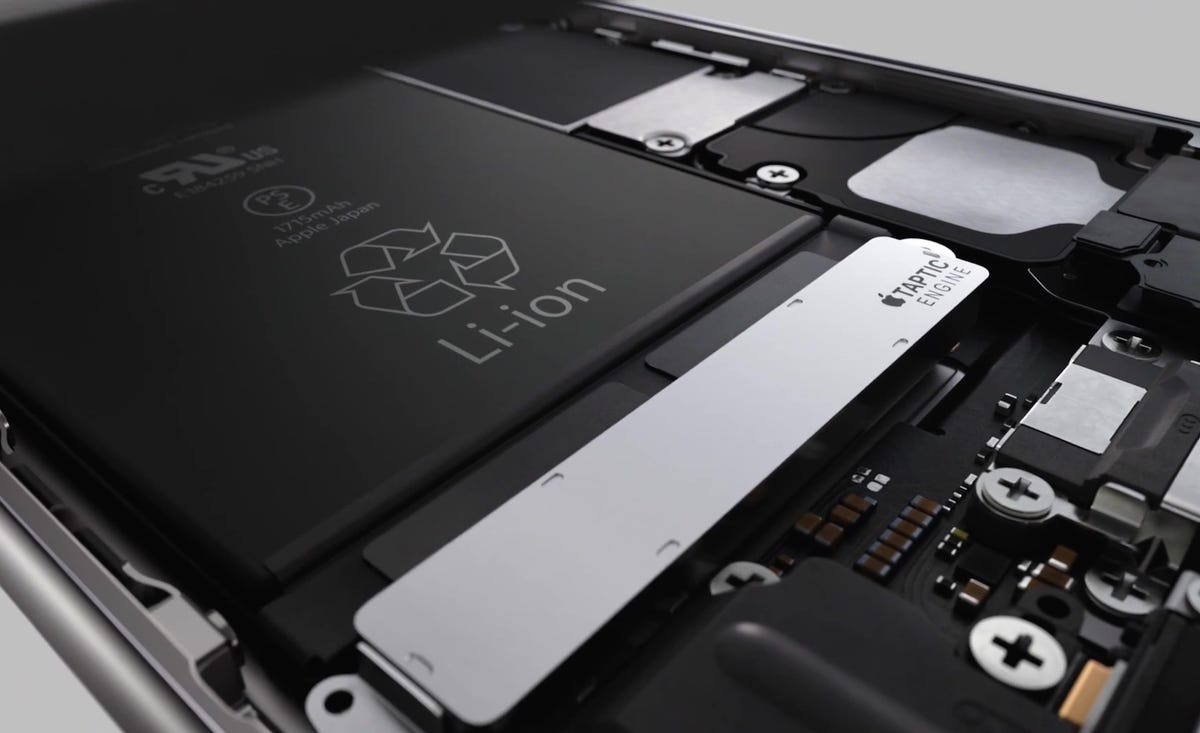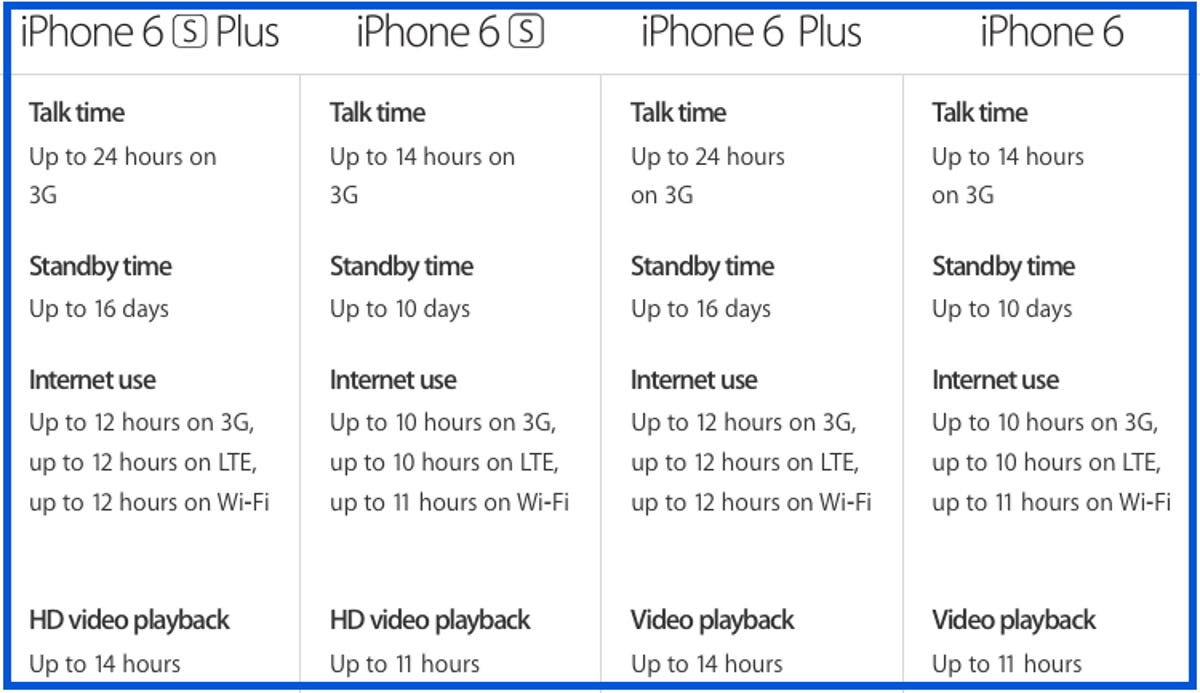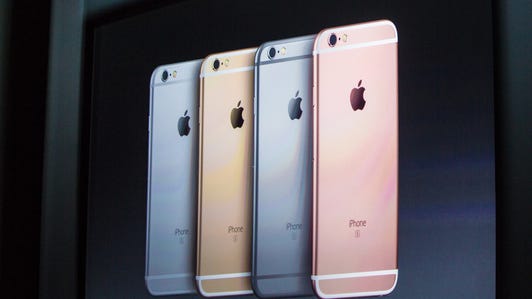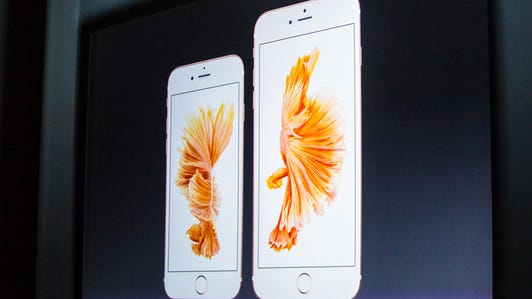 Enlarge Image
Enlarge ImageApple
In advance of Apple’s iPhone 6S and 6S Plus September 9 launch event, CNET was one of several sites around Web that served up polls asking readers what improvement they most wanted to see in the next iPhone. While these polls weren’t exactly scientific, the prevailing winner — in some cases by a wide margin — was improved battery life.
Alas, that didn’t happen. A quick check of the specs reveals that the rated battery life of the iPhone 6S is identical to its predecessor. (The iPhone 6S Plus also has the same battery life as 2014’s 6 Plus).
However, what’s more disappointing is that Apple own video flyby of the guts of the iPhone 6S confirms that Apple has equipped the iPhone 6S with a 1,715mAh battery — a lower capacity than the 1,810mAh version found on last year’s iPhone 6. (The “mAh” acronym stands for milliampere-hour, which is a measurement of a battery’s power capacity; the higher the number, the better.) And the the 6S Plus? The same MacRumors story that spotted the 6S battery capacity speculates that battery capacity on the bigger phone will dip down to 2,750mAh from 2,910mAh — but that isn’t confirmed yet.
Apple isn’t saying why it’s equipped the phone with a lower capacity battery, but the most likely answer is space. In order to keep the new models as thin as their predecessors while adding the new pressure-sensing 3D Touch feature (and the accompanying “Taptic Engine”), Apple had to go with a slightly smaller battery. That’s the keystone feature of the new models which allows you to choose different options and shortcuts depending how hard or lightly you press the screen.

 Enlarge Image
Enlarge ImageApple
That’s supposed to be OK, of course, because despite any battery differences the battery-life rating of the new phone is the same as the predecessor. Also, you’re getting the more powerful, faster A9 chip, which makes the iPhone 6S zippier with improved graphics performance while being energy efficient. You’re getting an engineering marvel, so there shouldn’t be anything to complain about.
But I’m in the camp that the cries for today’s phones to get a little thicker in exchange for improved battery life, particularly as Apple promotes using your iPhone in ways that are battery-intensive (video streaming, gaming, and excessive camera use). It’s also worth mentioning that having an Apple Watch tethered to your phone all day can’t have a positive impact on your iPhone’s battery life.
Apple’s design chief Jony Ive disagrees. In a March 2015 interview with the Financial Times, Ive brushed aside complaints about battery life, saying the iPhone was so light and thin that we use it so much and therefore deplete the battery. According to Ive — as paraphrased by the author — “With a bigger battery [the iPhone] would be heavier, more cumbersome, less ‘compelling’.”
Apple takes wraps off iPhone 6S and iPhone 6S Plus (pictures)






+16 more
OK, but compared to the iPhone 6S, the iPhone 6S Plus is heavier and more cumbersome and Apple doesn’t seem to be calling that model less “compelling.” It also doesn’t seem to ever talk about how many people are walking around with battery cases like Mophies on their phones (cases which prove that almost all smartphones sold today have the same two flaws).
Apple isn’t alone shrinking its battery sizes. Samsung’s 2015 Galaxy and Note phones all have slightly smaller batteries, too. (The results are mixed: the Galaxy S6 fared worse than the Galaxy S5 in CNET’s battery tests, but the Note 5 nicely outdistanced the Note 4 .) What’s clear is that Apple and many competing companies have decided that the typical high-end smartphone is supposed to have enough battery life to get you through a full day — at least with moderate use.
The only problem is that over time a lot of people find their phones want to take a siesta by mid-afternoon. Which is why people go out and buy battery cases. That’s fine, except for those of us who remember the pre-smartphone days of those tiny analog flip phones. True, they didn’t do much more than make phone calls or handle text messages (on a T9 numeric keypad to boot). But, you could go several days without recharging.
It’s true that battery life can be reduced by the way you operate your phone. There are apps you can turn off, settings to tweak and tricks you can learn to run it more efficiently. Indeed, iOS 9 (the new operating system which will be available September 16 for recent iPhones, iPod Touch models and iPads) is promising battery-life improvements, including a new low-power mode.
At the end of the day, even though Apple’s Ive is publicly pooh-poohing any battery-life issues, I suspect Apple’s engineers are hard at work coming up with a solution that will allow Apple to make the iPhone even thinner (iPod Touch thin?) while maintaining the same battery life or perhaps even improving it. It’s a challenge, though: Battery technology is notoriously hard to extend.
But there are always possibilities. A couple of months ago, Apple filed a patent for a potential solar-power charging technology. According to Patently Apple, the patent applies to “a new Apple invention that could use solar cells integrated into trackpads, the Magic Mouse, Magic Trackpad, Apple’s wireless keyboard and into parts of the iPhone that could provide added stored power.”
Could solar charging come to the iPhone 7? That seems a little premature, but who knows — maybe iPhone 7S.
In the meantime, we’re looking forward to testing the new iPhones to see how the battery persists in the real world.
Stay tuned.



